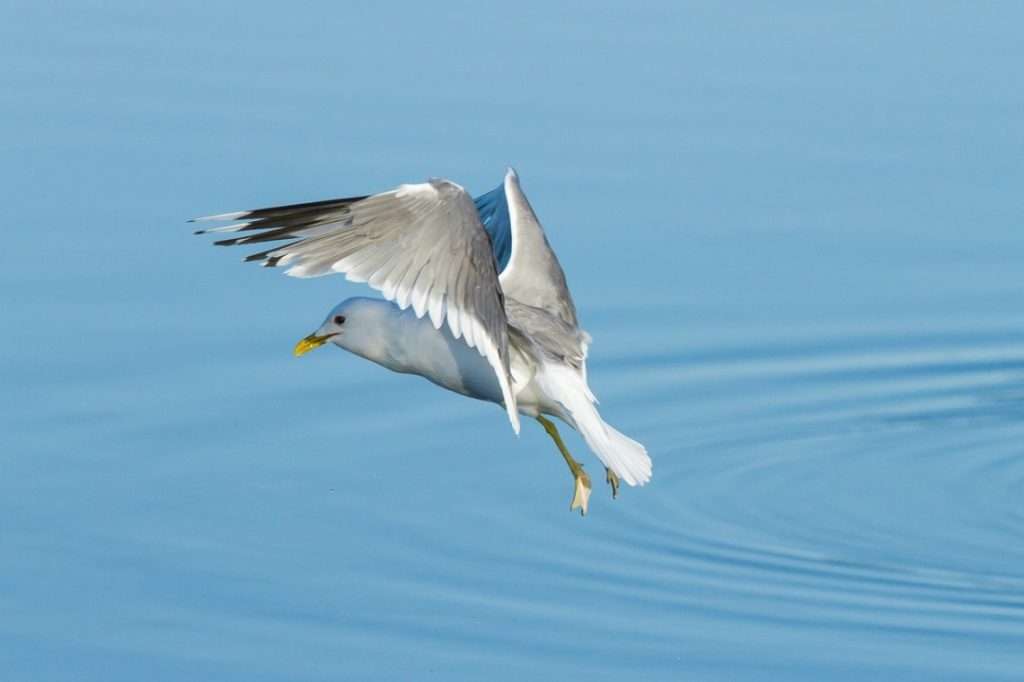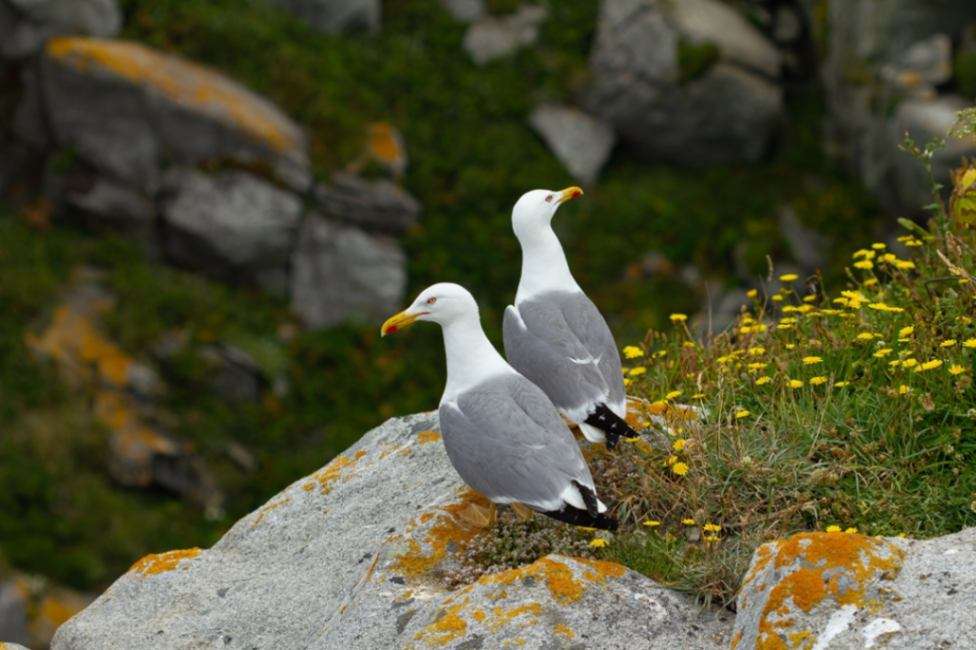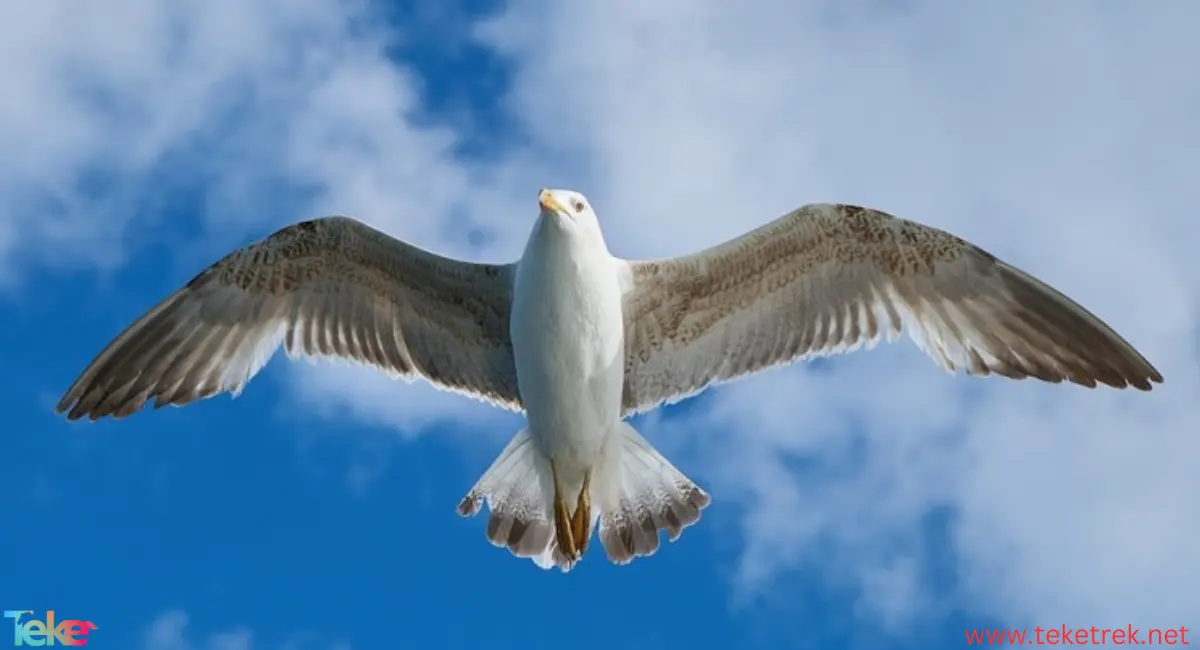Seagulls are considered one of the most beautiful creatures and prominent coastal birds around the world. Their captivating songs echo in the vast space, with remarkable voices and distinctive, exquisite shapes. Moreover, they symbolize freedom and hope, continuing to soar through the skies of life, crossing seas, rivers, and deserts, overcoming all obstacles with strength and determination.
In this article in TekeTrek Website, we will introduce you to the most important information related to this object. Follow along with us.

Information about Seagull meaning
- Seagulls belong to the family of birds known as “gulls.” Scientific Name: Larus canus.
- Seagulls are characterized by their large, tapered bodies, long, rounded wings, enabling them to travel between areas over long distances.
- They have many names, such as “sea pirate.”
- Seagulls have a thick, strong, hooked beak, which they use for catching fish and other marine animals. It is distinguished by its bright orange color.
- Seagull legs are long and slender, aiding them in walking on land and standing on rocks or sand easily. Their legs end with strong, sharp claws that help them catch prey and grip surfaces during flight or landing.
- Additionally, seagulls have broad wings and tails with rounded angles.
- The length of seagulls ranges from 28 to 81 cm, with a wingspan of 61 to 78 cm. They weigh between 68 to 162 grams.
- Some species of seagulls live for more than 20 years.
- Seagulls have feathers with various beautiful colors, ranging from white, gray, black, to brown. However, the predominant color is white.
- Moreover, seagulls may have additional colors on their necks, heads, wings, and tails.
- Seagulls have remarkable vision, allowing them to see clearly from a distance of up to two miles, thus able to detect predators from all directions.
- Seagulls have an excellent sense of smell, being able to detect food scent from a distance of over 3 miles.
- They are known for being noisy birds with loud voices.

Where do seagulls live?
- Seagulls live in coastal areas on cliffs and can also be seen in cities around waste dumps and parking lots.
- They inhabit various regions around the world such as North America, South America, and the Caribbean.
- Additionally, species of seagulls can be found in Brazil, Peru, and the coasts of the United States.
- Moreover, some species are widespread around Australia, New Zealand, the polar regions, South America, and South Africa
What do seagulls eat?
- Seagulls are opportunistic feeders and eat a wide variety of foods. They are known to consume human food like French fries and bread. Additionally, they are carnivorous birds and feed on fish such as sardines, salmon, and herring. They are skilled hunters and catch prey from shallow waters. Seagulls also enjoy shellfish, plankton, mollusks, sea snails, and even crustaceans like crabs. Furthermore, they scavenge on whale, dolphin, and seal carcasses, and they have been observed consuming nuts and legumes.
Seagull Reproduction
- Seagulls breed in coastal areas, islands, and some inland regions that provide suitable nesting environments. Mating pairs collaborate in building nests, which are typically found on the ground, rocks, or coastal vegetation. Breeding usually occurs between March and August. Seagulls begin breeding at around four years of age. They typically lay one or more eggs during the breeding season, and after an incubation period lasting four to five weeks, the eggs hatch, and the chicks emerge.
What are the characteristics of a seagull?
- Seagulls are distinguished by their ability to fly with ease and agility in the skies over seas and beaches.
- They can soar to great heights, swiftly and freely traversing vast expanses of airspace.
- Seagulls are migratory birds that undertake long journeys, moving between polar regions and tropical areas.
- Some species of seagulls have the ability to sleep while flying, allowing them to continue flying even while asleep.
- Seagulls move slowly and quietly, exhibiting a unique ability to relax and contemplate. They can remain motionless for long periods on rocks and beaches without moving.
- Seagulls do not usually attack humans unless they feel that their nests or offspring are in danger.
- Seagulls are known for their intelligence. They can play games and are skilled at stealing prey from other birds. They are also adaptable to various conditions.
- Seagulls have the ability to recognize people by their faces, especially those who feed them, and interact with them in various ways.
- A group of seagulls is called a colony, consisting of thousands of birds. They are found on coasts, beaches, lakes, ponds, marshes, and farms.
- There are more than 40 species of seagulls spread across different regions of the world.
- Their droppings are called guano. It is used as fertilizer for plants and crops because it contains ammonia salts rich in nitrogen, providing nutrients to the soil.
How Seagulls Benefit
- This magnificent bird contributes to regulating the populations of fish and insects. Its diet includes seafood, insects, and worms.
- Seagulls can carry plant seeds over long distances, aiding in the dispersal of plants and changing landscapes.
- Seagulls contribute to the production of agricultural fertilizer through their droppings, thus increasing crop productivity and improving its quality.
- They reduce the need for harmful chemical pesticides by feeding on crop-damaging insects, thereby contributing to environmental balance and plant health.


Types of Seagulls
- Western Gull: The largest in size among seagulls, with a wingspan of 1.6 meters. It lives in the northern seas of the Earth and in the state of Hawaii.
- California Gull: Lives in lakes and marshes from Canada to Colorado. This species spends its days searching for food on the water.
- European Herring Gull: Found throughout Europe, especially in Britain, Iceland, and Ireland. It eats crustaceans, fish, plants, and human food.
- Pacific Gull: Native to Australia. It is characterized by its white head, reddish-orange beak, and dark wings.
- Black-headed Gull: Known for its black head feathers, which turn white in winter. It lives throughout Europe, Canada, China, and Japan.
- Black-billed Gull: Also known as “Tarapuka,” it lives in New Zealand, its only habitat.
- Ring-billed Gull: Found in North America and Canada. It is characterized by its short yellow beak with a thick black band.
FAQ
- What is the difference between a gull and a seagull?
The term “gull” refers to any bird in the family Laridae, while “seagull” specifically refers to gulls found near coastal areas or in marine environments. Essentially, all seagulls are gulls, but not all gulls are necessarily found exclusively near the sea.
- What Seagulls Sound Like?
Seagulls emit distinctive sounds called calls or cries.
- Are seagulls harmless?
Seagulls are generally harmless to humans when left undisturbed. However, they may become aggressive if they feel threatened or if they are seeking food.
- What are seagulls most afraid of?
Seagulls are known to be wary of potential threats, including larger predators such as birds of prey or mammals like dogs or humans. They may also exhibit fear responses to sudden loud noises or unfamiliar objects. Overall, their fear responses are primarily geared towards avoiding potential danger and protecting themselves from harm.
- What do seagulls symbolize?
The seagull is considered a symbol of freedom and hope, representing the power of flight and soaring freely over the seas and shores. It is also assumed that the appearance of a seagull in one’s life may signify a new beginning or a period of change and development.
- Why do seagulls scream at night?
Seagulls may emit sounds at night if they are stressed, fearful, or disturbed by sudden sources of light or strange noises, or perhaps due to other reasons such as disturbances in the environment or changes in natural conditions.
- Is a seagull predatory?
Yes, the seagull is considered predatory. It feeds on a variety of marine animals such as fish, crustaceans, mollusks, plankton, and small birds.


In Conclusion
In conclusion, the seagull remains a fascinating creature worthy of attention and care. It symbolizes love and nobility and has been a beloved subject in literature and art throughout history. With its captivating appearance and rich history, it has become a source of inspiration for writers and poets. Additionally, seagulls have found their place in myths and cultures around the world.






